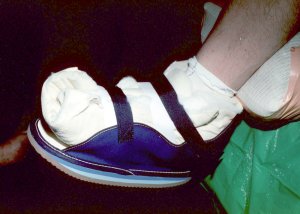The pros and cons of various Casting options for diabetic feet
We use Total Contact Casts, Slipper casts, and pneumatic walkers at our clinic.
Total Contact Casts
Advantages:
- Provide good pressure relief for ulcers.
- Provide stability for Charcot joints.
- Effective for use on "non-compliant" patients who might otherwise remove the splint and not wear anything on their foot.
Disadvantages:
- Not suitable for the elderly patients as they can find walking with them makes them unstable.
- Not suitable for use in the bathroom. The steam can soften the Plaster of Paris, so should not be used in a shower or bath even when covered in a waterproof cover.
- Cannot be used for longer than 3 weeks because due to the reduction in swelling of the leg the cast becomes loose and this can be dangerous.
- More expensive than pneumatic walkers (approx. £275 including the dressing costs)

Pneumatic Walkers
Advantages:
- Light and easy to keep clean.
- Patients generally prefer them to the plaster cast.
- Can be removed for bathing and sleeping.
- Good for active Charcot feet.
- More suitable for frequent dressing changes.
- Suitable for vascular patients and where swelling is present.
- Cheaper than Total Contact Casts (approx. £150 including dressing changes)
Disadvantages:
- No good for non-compliant patients
- No good for oversize patients - a TCC or slipper casts are more suitable for those.

Slipper casts
Advantages:
- Suitable for elderly patients
- Suitable for toe ulcers and forefoot ulcers
- Can be used when other types of cast cannot be used
- Can keep ulcers healed whilst waiting for special diabetic shoes to be made.
- Can be made removable for dressing changes


